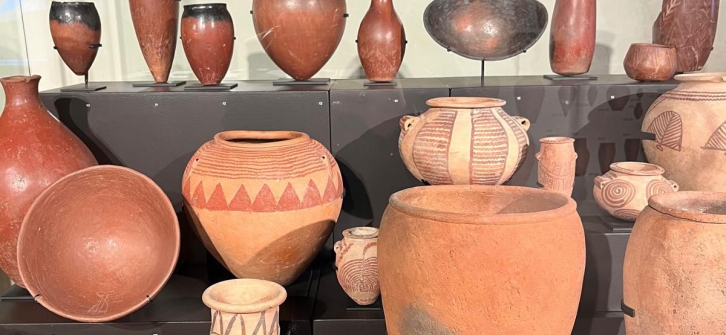Terres du Nil: LтАЩart des potiers avant Pharaon

Last December at Musée d'Archéologie nationale - Domaine national du Château de Saint-Germain-en-Laye I attended the exhibition “Terres du Nil: L’art des potiers avant Pharaon” on the pre-dynastic Egyptian history.
It featured over 120 pieces of pottery that came to France in the early XX century thanks to the brothers Jacques and Henri de Morgan, explorers and researchers who contributed to the study and recognition of Egyptian prehistory.
In addition, the exhibition included letters, diaries and notes taken by the de Morgan brothers during their time in Egypt, and explained how archaeologists observe and identify this kind of pottery.
For example, did you know that the clay of the Nile, known as Nile silt, is a product of erosion transported by the river from the mountains of Ethiopia to Egypt during its floods? This clay varies from gray to almost black and contains large amounts of silicon and iron oxides, which turn red to brown when fired in an oxidizing atmosphere kiln.
Potteries were also made with limestone or marly clay, which is mainly found at the outlets of wadis, rivers with irregular regimes. This yellowish-to-white clay contains a low percentage of silicon and a higher proportion of calcium carbonate. It takes on a cream or white color when fired in an oxidizing atmosphere, and its section may have pink or orange areas.
The classification system of pre-dynastic Egyptian pottery is based on the work of W. M. F. Petrie:
- Black-topped (B): polished red pottery with a black edge
- Red polished (P): polished red pottery
- White cross-lined (C): polished red pottery with white or cream painted decoration
- Incised (N): black pottery with incised geometric decoration highlighted with white pigment
- Rough (R): pottery with a rough appearance, made of silt mixed with a vegetable degreaser, which, when burned during firing, leaves vacuoles and roughness on the surface
- Decorated (D): pottery with a regularized surface, beige to pink-orange in color, with painted decoration in red ocher to brown, often with wavy handles
- Wavy-handled (W): vases with applied wavy handles, whose evolution results in a simple line
- Late (L): marly clay pottery
- Fancy (F): pottery with fanciful or animal-shaped designs.
This article has been viewed 47 times.




















